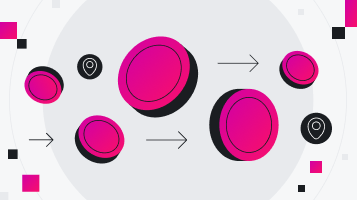LTV to CAC: How to find the perfect ratio for your startup

Customer lifetime value (LTV) and customer acquisition cost (CAC) are metrics every business should pay attention to. But the LTV CAC ratio is important, too.
The LTV to CAC ratio represents the amount of profit a customer brings in over the expense it takes to acquire and convince them to buy your product or service.
It’s one of the most important business metrics your startup should monitor when analysing your business’s growth, progress and success.
And although calculating your LTV to CAC ratio isn’t difficult, the process of knowing it and taking steps to improve it is the real test.
Here, we’ll run you through how to calculate your ratio, answer the question: 'What is a good LTV to CAC ratio?’ and address methods for improving yours.
What is customer lifetime value (LTV)?
Customer LTV (aka CLV or CLTV) is a metric that represents the total amount of revenue your business can expect from one customer throughout your relationship with them. It’s the monetary value you’ll earn from a single customer’s predicted account lifespan.
So, the longer a single customer continues to purchase from your business, the greater their LTV becomes.
This is why it’s important to prioritize customer support and success. Those aspects help improve a customer’s journey, which makes it more likely that they’ll remain loyal to your business.
LTV helps your business identify segments and target customers more effectively to boost loyalty. And while losing customers isn’t always a bad thing, it never hurts to reduce churn!
[Related: How to calculate and improve monthly recurring revenue (MRR)]
What is customer acquisition cost (CAC)?
Customer acquisition cost (CAC) is the total amount of sales and marketing costs required to gain a new customer.
Your CAC includes any expenses related to your marketing programmes, salaries and commissions, as well as any overhead costs put towards attracting leads and turning them into customers.
Regardless of the business sector you’re in, the goal is to make your CAC as low as possible. Having a low CAC doesn’t just help you increase your profits — it’s also a sign that your sales, marketing and service programmes are healthy and in good standing.
You can think of CAC as a comparison between the amount of money you spend on attracting customers versus the number of customers you actually gain.
Additionally, retained customers are happy ones. And because they're satisfied with the services or products your business provides, they’re more likely to leave positive reviews and testimonials, as well as refer others to your business. This helps you gain more leads at no cost.
And if those leads become customers, that further lowers your CAC.

How to calculate LTV to CAC ratio
Calculating your LTV CAC ratio means dividing the total sales of a single customer over their lifetime with your business by the amount of money it takes to “convince” a customer to make their first purchase.
That said, you have to know how to calculate your LTV and CAC separately.
How to calculate customer lifetime value (LTV)
Lifetime value is the implied monetary value throughout the time a customer purchases from your business.
Now, let’s go over how to calculate customer lifetime value (LTV).
Here’s the customer lifetime value formula:
LTV = 1 ÷ Churn rate percentage
As with any business, sometimes you lose customers — this is your churn.
In the case of a software-as-a-service (SaaS) business, sometimes customers unsubscribe or stop purchasing. Your churn rate is the percentage of existing customers who unsubscribe or stop purchasing from your business within a given year.
In terms of SaaS businesses, if your annual customer churn rate is 7% (meaning 7% of existing customers canceled their subscriptions or another service, depending on your SaaS business type), then your LTV is 1 ÷ 7%, which is about 14 years. This is the average length of time a customer continues their relationship with your business.
Now that you know how to calculate your LTV, we’ll move on to CAC.
How to calculate customer acquisition cost (CAC)
Calculating customer acquisition cost isn’t difficult. And once we have it, it becomes the denominator in the LTV CAC ratio.
CAC is the total amount of money it costs to convince a customer to make their first purchase. You can think of it as the sum of your sales and marketing expenses divided by the number of new customers you acquire. Or in other words, it’s the number of leads who become customers.
Here’s the formula for calculating cost per acquisition:
Customer acquisition cost (CAC) = Total sales and marketing costs ÷ Number of newly acquired customers
Before looking at a calculating cost of customer acquisition example, you should know that acquiring new customers requires using a variety of tactics. Such tactics include methods for effective marketing, use of sales channel outlets (e.g. social media, website work) and even in-person efforts.
For example, if you run an eCommerce business, your numbers for calculating CAC for a particular month might look like this:
Marketing expenses: USD10,000 for paid advertising and content marketing
Sales expenses: USD21,000 for a sales campaign
Additional expenses or maintenance costs: USD4,000
Number of customers acquired: 437
Using the numbers above, you can add your total expenses (in this case, they equal USD35,000). Then, divide that value by 437. Your CAC is just over USD80.
So, what is a good customer acquisition cost? Well, it depends.
You want your LTV CAC ratio to be 3:1. So knowing whether your CAC is good depends on how high your LTV is.
How to calculate your LTV CAC ratio
You can measure the effectiveness of your sales and marketing strategies using the LTV CAC ratio. To calculate your LTV CAC ratio, simply divide your LTV by your CAC.
Here’s the LTV CAC ratio formula:
LTV CAC ratio = LTV ÷ CAC
The US Generally Accepted Accounting Principles (GAAP) have reporting standards that fall on the traditional side. They especially fall short when examining the financial performance of SaaS businesses.
That’s why eCommerce and SaaS businesses usually rely on their own set of key business metrics to bridge what GAAP standards miss. Businesses with repeat purchases (e.g. eCommerce and SaaS businesses) are direct-to-consumer, which is why it’s helpful to know LTV, CAC and the LTV CAC ratio.
The LTV CAC ratio helps startups take specific actions:
Examining the cost-effectiveness and efficiency of their sales and marketing efforts
Determining whether their customer acquisition strategies are feasible in the long term
[Related: Key performance indicators for emerging eCommerce businesses]
What is a good LTV to CAC ratio?
The ideal LTV CAC ratio is 3:1. This means you should aim to earn three times more than what you spend on acquiring customers.
If your ratio is less than 3, you should look into how to lower customer acquisition cost. This usually means reducing your sales and marketing expenses — at least for a bit.
[Related: Profit margins: 5 things every startup founder needs to know]
How to improve your LTV to CAC ratio
Here are some tips for improving your CAC LTV model.
Use the right channels
The sales channels that might attract and snag the most customers aren’t always the ones that work best if customers are quickly churning.
Investing in channels that boost your inbound marketing is ideal. About 81% of customers do research before making a purchase. So if you have a focused, targeted approach, the leads you attract are likely to be more interested in the services or products you offer.
You’ll end up with more loyal, long-term customers, and you’ll spend less money on attracting them.
Reduce complexity of sales
If you have a complex sales process or a sales cycle that’s on the longer side, your CAC will inevitably be higher.
Your startup should aim to engage prospects with a simple yet effective onboarding process. If shopping is a hassle and hardly fun, who would do it, right?
Invest in a tight funnel that makes each step in the sales process easy to understand and navigate. This will help you gain and retain more customers.
Change your pricing structure
Try experimenting with your pricing.
You could even try pricing tiers (e.g. feature-based, seat-based) or add-on options.
The more customers you move from a cheap or freemium plan to a premium plan, the lower your CAC will be.
So if you want to be profitable and improve customers’ time to value, you simply have to reduce your cost of revenue. And most of that cost comes from CAC if you’re a digital business.
[Related: The complete guide to eCommerce accounting: Selling across borders]

Scale your business across borders with Airwallex
Airwallex helps eCommerce and SaaS businesses streamline their finances and improve their profits.
Our Global Business Account allows you to open 11 foreign currency accounts for free at the click of a button. Collect, hold and send multiple currencies — including USD, GBP, EUR, AUD and HKD — from your account with zero transaction fees, and convert currencies at our bank-beating exchange rate.
We also offer Borderless Cards, Online Payments and integrations with your wider tech stack, including Shopify, Magento and Xero.
We make it easier and more cost efficient to manage money globally. To get started, sign up for free today.
Share
View this article in another region:AustraliaHong Kong SAR - EnglishHong Kong SAR - 繁體中文United KingdomGlobal
Related Posts

How to use Airwallex for automated insurance payouts
•5 minutes

BIN sponsorship | How it can help your business
•9 minutes
